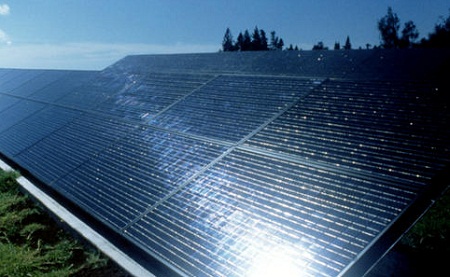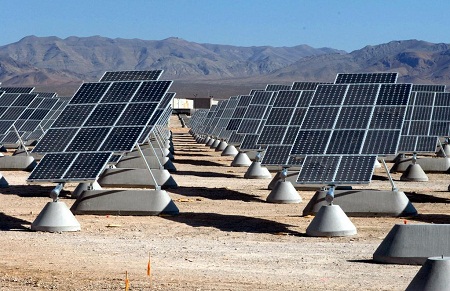Look at a map of Southern California, and you’ll see several large gray patches. These depict sprawling bases, testing ranges, weapons stations, airfields – you name it – that the various branches of the U.S. military oversee. And according to a new U.S. Department of Defense (DOD) study, these swaths of desert land could be gold mines for solar power.
The department’s Office of Installations and Environment concluded that 96 percent of the surface area of nine desert military installations it studied (including two in Nevada) would have to be off limits to solar projects for military or environmental reasons. But that still left 25,000 acres judged “suitable” for development, and all told the study said 7,000 megawatts of solar energy capacity was technically and economically feasible.

Of course, just because the DOD thinks the land is suitable for solar development doesn’t mean everyone else will – and in its report the military acknowledged that there would be questions about who would oversee private-investor led solar development on what are known as “withdrawn lands.” These are lands that are part of the public domain supervised by the Department of the Interior’s Bureau of Land Management (BLM), but that have been withdrawn from the operation of public land laws to serve military mission needs. If they weren’t being used for military purposes, would it still up to the DOD to decide their fate? Or would the BLM step in? And what role might the state of California play? How these questions are answered could determine what environmental-review processes and regulations come into play, and the pace and success of development.
The military said its 7,000 MW figure was based on the assumption that development would happen on all 25,000 of the acres rated “suitable” as well as one-quarter of the 100,000 acres rated “likely” or “questionably” suitable for solar, adding up to 50,000 acres. And by “economically feasible,” the report’s authors meant that projects would be enticing to private developers taking advantage of federal and state tax-based incentives. “Projects funded by the government (e.g., using military construction funds) were not viable,” the report said, “given the current costs of the technology and the tax-based nature of federal solar incentives.”
Still, the study said, the government could get a lot out of such development, including rental fees and cheaper power that could be worth $100 million annually. In fact, the DOD suggested the government could do better than it is under the BLM’s current leasing program, writing, “BLM’s solar land lease rates could increase substantially and still provide an attractive rate of return for private developers under the study’s assumptions.”
The study looked at the full range of solar development possibilities on the bases and determined that crystalline-silicon PV with single-axis tracking had the best potential “due to its combination of low cost of installation and high electricity output.” Other PV technologies – including thin-film – could also be viable, the study said, but concentrating solar power technologies that were studied “were not economically viable in most cases due to their higher installed costs.”
While the researchers began by looking at nine bases in the Mojave and Colorado deserts, they eventually narrowed their focus to four bases in California with significant acreage prime for development: Edwards Air Force Base (24,327 acres), Fort Irwin (18,728 acres), China Lake (6,777) and Twentynine Palms (553 acres).

The study emphasized that the development could occur “without impact on mission performance and can result in substantial value delivery” to the Defense Department. It added, however, that “a thoughtful program, with the necessary funding, leadership support and capacity building” would be necessary to actually make it happen.
Both a 17-page executive summary [PDF] of report and the full 532-page document itself [PDF] are available online. You gotta love thick, multi-page government documents.